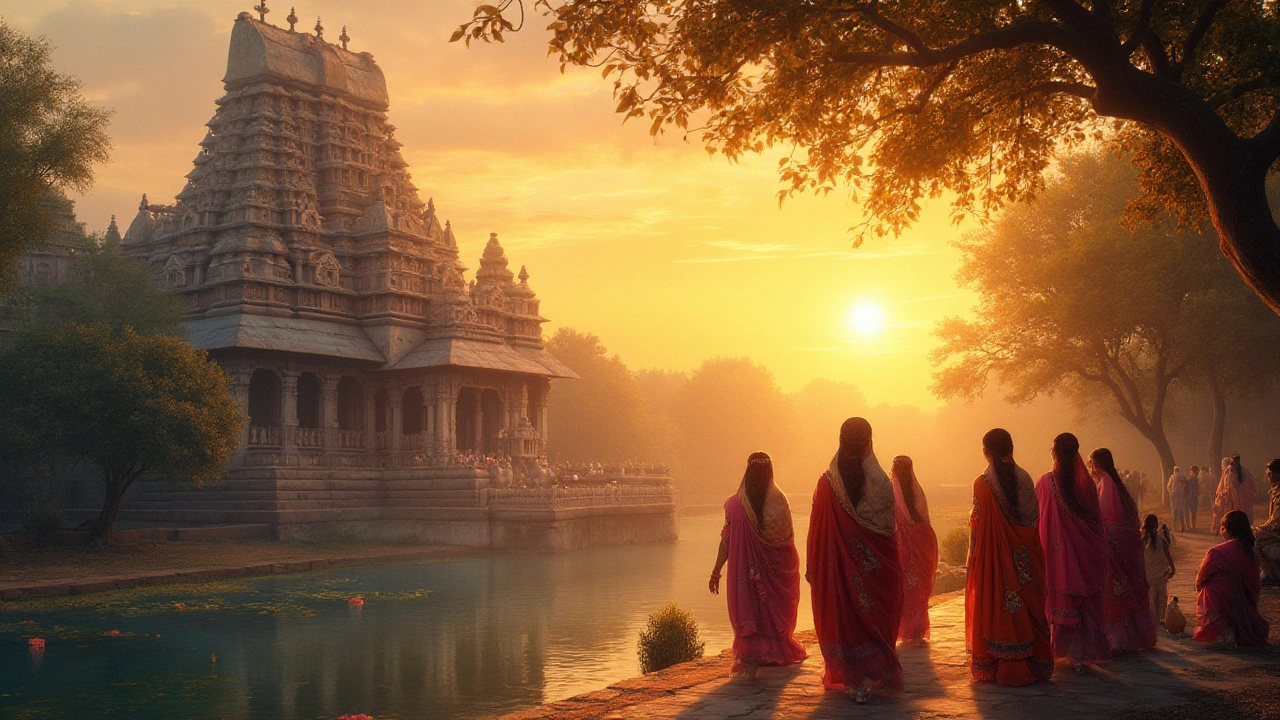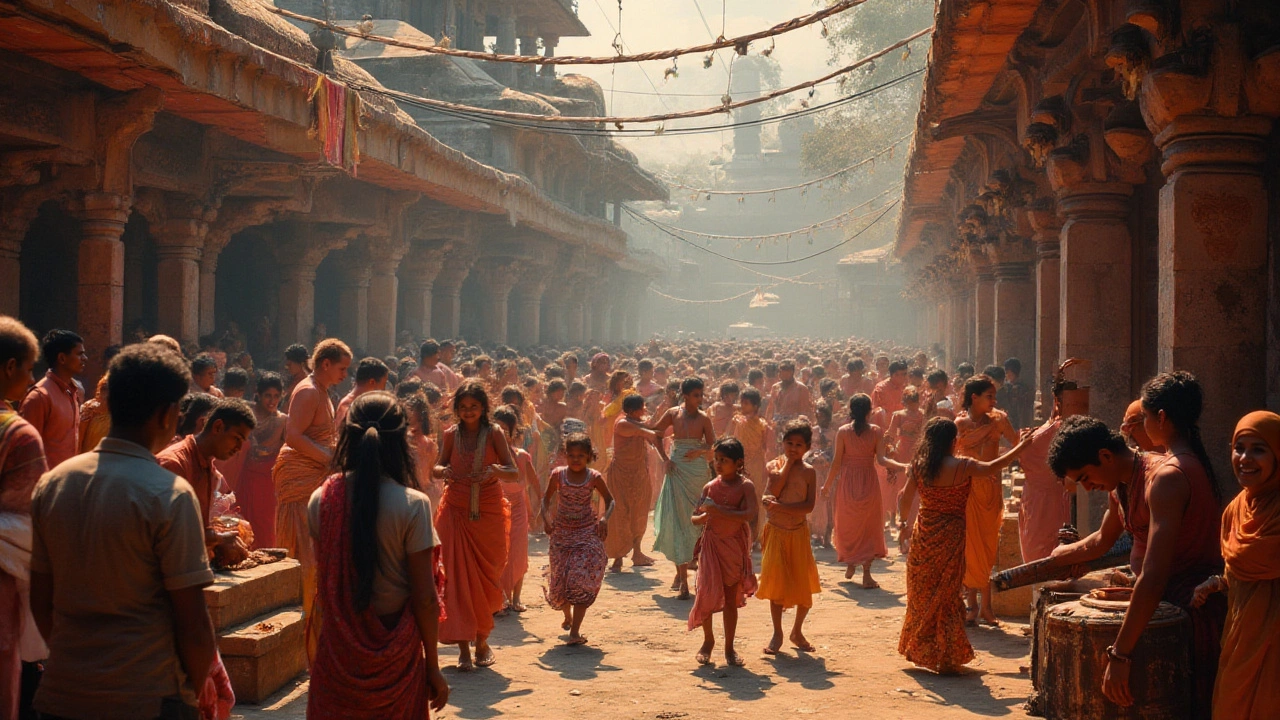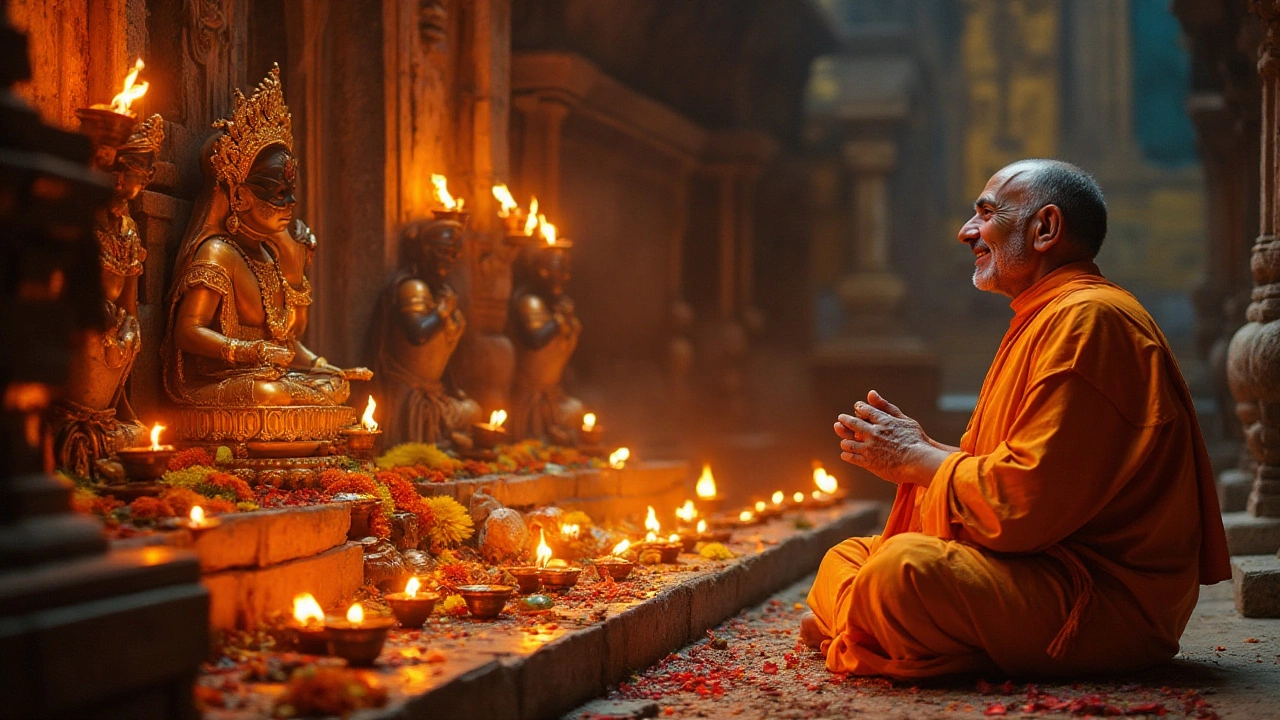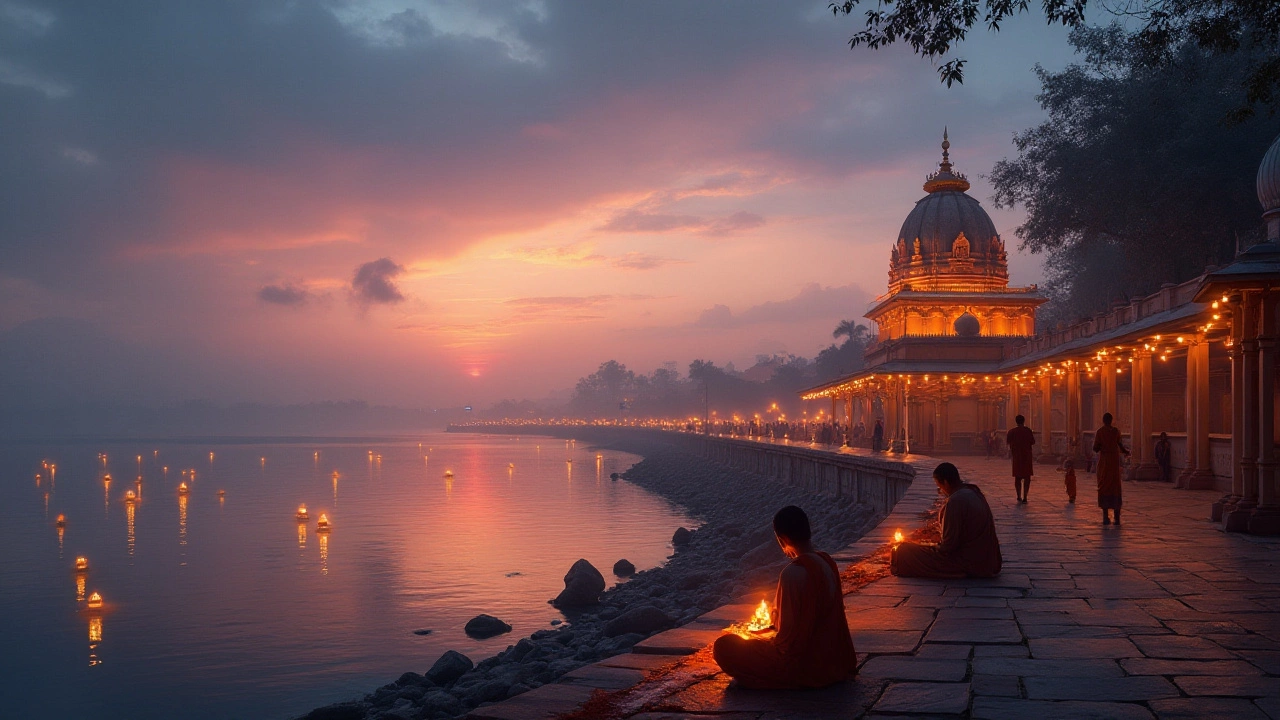Exploring India's Sacred Temples: Essential Tips and Experiences
 Dec, 23 2024
Dec, 23 2024
India, a land imbued with spirituality and ancient traditions, is home to countless temples that echo the country's vibrant culture and history. Touring these temples is not just about exploring their remarkable architecture but also about engaging with the serene and often mystical atmosphere that envelops them.
Before embarking on this spiritual journey, it's important to understand the nuances of temple etiquette, local traditions, and the practicalities of visiting some of the country's most revered sites. This guide will illuminate the path for a fulfilling experience, whether you're attending a vibrant festival or seeking a moment of quiet contemplation within the temple's sacred walls.
- Understanding Temple Etiquette
- Best Temples to Visit
- Experiencing Local Traditions
- Practical Tips for Your Temple Tour
Understanding Temple Etiquette
When embarking on a journey to the sacred temples of India, it's essential to acquaint oneself with the local customs and practices that govern temple etiquette. These sacred spaces are more than just architectural wonders; they are spiritual sanctuaries where devotees and visitors alike come for solace and reflection. Visitors offering respect to these traditions not only enrich their own experience but also honor the spiritual significance these sites hold for millions.
One of the first things to note is the practice of removing shoes before entering a temple. This simple gesture is universal across Indian temples and signifies the act of leaving the material world behind and stepping into a realm of the divine. Many temples provide designated areas where you can safely store your footwear. As a practical tip, wearing easily removable shoes can save time and effort.
Dress code is another crucial aspect. Generally, modest attire is appreciated, with shoulders and knees covered for both men and women. Some temples may offer shawls or wraps at the entrance for those who may need them. This reflects the respect one has for the sacred atmosphere, allowing one to blend into the spiritual tapestry of the temple.
Respecting daily rituals and ceremonies is also important. Many temples follow a specific schedule for rituals, and it's advisable to remain quiet and unobtrusive during these times. Photography is often discouraged or outright banned within the inner sanctum, given the sacred nature of the temple rituals. When in doubt, always seek permission or guidance from the temple staff.
Offerings, or 'prasad', often play a significant role in temple visits. Visitors may offer fruits, flowers, or other items to the deities. These offerings are symbolic acts of devotion and communion. Occasionally, as in the famous Tirupati temple, laddus, a sweet delicacy, are distributed as blessings. Participating in these customs can provide a deeper insight into the devotional life that thrives within Indian temples.
Observing and respecting these nuances of etiquette allows visitors to truly immerse themselves in the spiritual ambiance. As famously quoted by Swami Vivekananda, "Each temple is not merely a contemplation, but a vibrant and majestic expression of divine harmony." By respecting these spaces, you become a part of that expression.

Best Temples to Visit
India, with its vast array of temples, promises an extraordinary journey through history and spirituality for those willing to explore. Among the many, some stand out for their architectural brilliance, historical significance, and spiritual ambiance. One cannot start this journey without mentioning the majestic temple tours in India, beginning perhaps with the iconic Varanasi. As one of the oldest living cities in the world, Varanasi is home to the Kashi Vishwanath Temple, dedicated to Lord Shiva. This temple is nestled along the banks of the sacred Ganges, offering visitors a profound sense of tranquility as they participate in the mesmerizing evening Ganga Aarti ceremony.
Heading south, the captivating architectural marvel of Meenakshi Temple in Madurai beckons. This temple complex is a significant pilgrimage site, not just for its spiritual importance but for its striking gopurams that tower majestically over the city. The temple is an exceptional example of Dravidian architecture, with its detailed carvings and colorful sculptures that portray stories from ancient folklore. Visitors can explore the thousand-pillared hall, which, despite its bizarre name, invites you to gaze at columns each depicting intricate artwork that leaves one in awe. Every corner here tells a story, much like the country's diverse past.
Not far from Madurai lies the ethereal Shore Temple at Mahabalipuram, perched elegantly on the Bay of Bengal's shores. Constructed in the 8th century, this temple is part of the UNESCO World Heritage Sites, and rightly so, as this represents the culmination of Pallava architecture. Its picturesque setting has inspired artists and wanderers alike for centuries. As the sun sets, casting a golden hue on its robust granite structure, it’s a moment that stays etched in the memory of every visitor. This temple showcases the convergence of splendid architectural design and the serenity of the surrounding seascape, making it a truly Indian temple experience.
The northern region is not without its wonders either, where the Jagannath Temple in Puri holds a special place in India's religious panorama. Famous for the annual Rath Yatra, where the deities are taken out in a grand procession, this temple draws millions of devotees each year. Its towering spire, intricately carved, sets the backdrop for an intense spiritual vibe that encapsulates the heart and soul of such sacred traditions. “The diversity and depth of culture in Indian temples is unmatched,” states renowned cultural historian, Vivek Sinha.
The roots of India's temple culture run deep, intertwining with the everyday lives of the communities around them, reflecting the nation's soul.These words resonate as pilgrims and tourists alike continue to be mesmerized by the rich tapestries of history and devotion that these spaces represent.
To encapsulate the distinctive characteristics of visiting temples in India, yet another celebrated destination is the Golden Temple in Amritsar. An emblem of Sikh architecture, the temple’s stunning golden façade and serene Amrit Sarovar (pool) create a reflective haven. The Guru Granth Sahib, the central religious scripture of Sikhism, is housed here, and the temple is known not only for its spiritual significance but also for its heartwarming tradition of langar – a free meal served to all visitors, keeping alive the tenets of humility and service. These magnificent sites, when viewed not just through a lens of architectural wonder but with an acknowledgement of their spiritual and cultural importance, offer visitors a truly enriching journey through the heart of temple travel tips.

Experiencing Local Traditions
When stepping into the world of Indian temples, you're diving into an ocean of rich temple travel tips and cultural nuances that have been shaped over millennia. Whether it's the rhythmic chime of bells or the soothing aroma of incense wafting through the air, each temple offers a unique experience deeply rooted in local traditions. The key to truly appreciating these sacred places is to immerse oneself in the daily practices and rituals that make each temple an irreplaceable part of its community.
One common tradition across many temples in India involves the act of circumambulation. Devotees walk clockwise around the sanctum, symbolizing the cycle of life and death and an alignment with spiritual energies. The journey, marked with prayer or silent reflection, serves as both an act of devotion and an opportunity for introspective contemplation. Participating in this tradition as a visitor can provide an intimate glimpse into the spiritual practices that underlie the fabric of religious life in India.
Local festivals provide another vibrant opportunity to experience temple customs. For instance, during the famous festival of Diwali, temples like the Golden Temple in Amritsar illuminate with thousands of lights, creating a breathtaking spectacle. Witnessing such events can be transformative, as the communal spirit and fervor offer a deep understanding of the cultural significance of these ancient traditions. As historian Linda Hess once observed,
"The lights of Diwali are a beacon of hope and community spirit, transcending beyond just religion."
Additionally, understanding and partaking in temple attire customs is crucial. Many temples require visitors to adhere to a dress code, emphasizing modesty and respect. Women often wear saris or cover their heads, while men might be required to wear dhotis or mundus. Embracing these practices not only shows respect for the local culture but also allows you to engage more fully with the community, fostering a sense of belonging and camaraderie.
Interactive rituals like offering flowers or lighting candles also provide a tactile engagement with the spiritual essence of the temple. These acts serve a symbolic purpose, representing the shedding of negativity and the embracement of positive energies. Participating sincerely in these offerings can provide a moment of serene connection with the divine, a reflective pause in our often hectic lives.
The architectural grandeur of Indian temples is itself a tribute to the traditions sustained within. From the intricate carvings of the Meenakshi Temple in Tamil Nadu to the serene simplicity of the Ajanta and Ellora caves, each structure tells the story of the civilization that built it. These marvels weren't just built for worship but also to pass on the legacy of artistic prowess and spiritual ingenuity from one generation to the next. Here, art and devotion amalgamate, offering a plethora of inspiration for those keen on understanding cultural history through architecture.
For those worried about language barriers, English is widely spoken, but learning a few phrases in the local tongue can enrich your visit. Greetings or expressions of gratitude in Hindi or Tamil, for instance, can open doors to warm exchanges and smiles that transcend verbal communication. Conversations with locals might also unlock tales of the temple and its significance that aren't found in guidebooks, adding depth to your Indian temple experiences.

Practical Tips for Your Temple Tour
When setting off on a journey to explore the majestic temples of India, there are several key tips that can enhance your experience significantly. These sacred places, often bustling with activity and steeped in ancient traditions, provide a unique insight into India's spiritual heart. To make the most of your visit, consider planning your trip during the cooler months from October to March, when the weather is more favorable for exploration. Keep in mind that popular temples, particularly in cities like Varanasi and Puri, can be quite crowded during major festivals, which can add to the excitement but also require a bit of patience and flexibility in your schedule.
One essential aspect of visiting Indian temples is understanding and respecting local customs. Many temples require visitors to remove their shoes before entering; some may even have restrictions on the type of clothing worn. Generally, modest attire is advised, covering shoulders and knees, which is not only respectful but also comfortable for the sometimes rigorous activities involved in temple visits. Certain temples might have unique dress codes, so it's worth checking ahead or carrying a scarf or shawl for convenience. On bustling temple grounds, where the faithful come together for prayer and ceremony, being mindful of your surroundings and the practices taking place can enhance both your understanding and appreciation of these vital cultural experiences.
For those who are keen on photography, capturing the intricate details of temple architecture and the myriad of emotions on display can be incredibly rewarding. However, remember that some temples have specific regulations on photography, particularly in sanctuaries or during rituals. Always ask for permission if you are unsure, as photographing sacred idols or recording ceremonial activities might be prohibited. Respecting these guidelines ensures that your presence remains unobtrusive and considerate of the spiritual activities taking place. Immersing yourself in the vibrant tapestry of sights and sounds without the distraction of a camera lens can sometimes lead to more enriching experiences.
A practical tip that should not be overlooked is staying hydrated and maintaining personal comfort throughout your temple tours. While exploring, you'll likely find yourself walking considerable distances and spending long hours on your feet, especially when visiting expansive complexes such as the Meenakshi Amman Temple in Madurai or the Sun Temple in Konark. Carrying a reusable water bottle is advisable, though be sure to adhere to temple guidelines on where to carry such items as some may prohibit their entry beyond certain areas. Similarly, having a small supply of basic necessities, like a light snack, sunscreen, or sunglasses, can be immensely helpful as you navigate the temple grounds, keeping your focus on exploring rather than being disrupted by discomfort.
To immerse yourself deeper into the experience, consider engaging with knowledgeable local guides who can offer insights into the temple's history, significance, and architecture. Conversations with people who have firsthand stories and ancestral connections to these sacred places can often provide layers of understanding beyond what is available in guidebooks or digital resources. In fact, Dr. R. Prakash, a noted historian, once remarked, "The true essence of Indian temples isn't just in their stones and silence but in the stories they hold and the lives they've touched." Taking the time to listen to these narratives can turn a simple visit into a cherished memory.